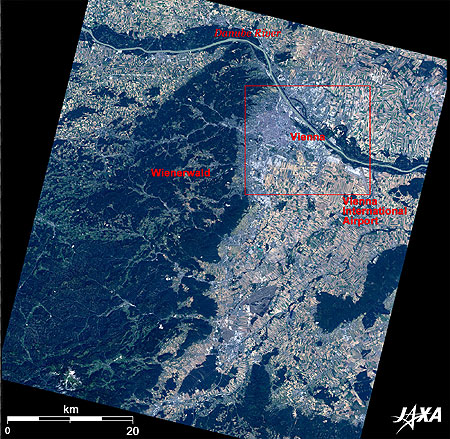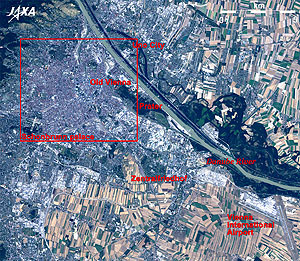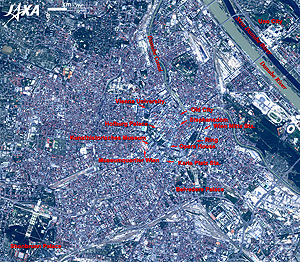Seen from Space 2007
Music and Habsburg dynasties in Vienna
The deep-green area at the left of figure is the vast forest of Vienna (Wienerwald) including wine fields. Vast fields also appear in the upper right of the figure. These green areas are blessed with rich nature. Many European towns developed along rivers, just as Vienna developed between of the Danube River and the Vienna forest. This location was easily defensible against foreign enemies. Vienna has been loved by many musicians. It is said that Beethoven composed Symphony No. 6 Op. 68 "Pastoral" in the forest of Vienna. The white area in the right of figure below the Danube River is the Vienna International Airport. Located 20km from central Vienna, it is a hub airport in Europe and has many airline routes.
You can also see another canal on the opposite side. It is the old city of Vienna. The large green area to the right of the old city is Prater. It was an old hunting ground but is now a place of relaxation and recreation for citizens of Vienna after being opened to the public by Emperor Joseph II in the 18th century. Vienna's Prater Park includes the Giant Ferris wheel that appeared in the British suspense film, The Third Man, which was set in Vienna. The Central Cemetery (Zentralfriedhof) of Vienna lies between central Vienna and Vienna International Airport; it is the burial site of many musicians, including Beethoven, Schubert, Brahms, and Johann Strauss I and II, and it also has the Mozart memorial. Forming a cross in the left of the figure is Schönbrunn Palace, a detached summer palace of Habsburg monarchs. The palace was built in the Baroque Architecture style by Emperor Leopold I in a hunting woods in 1695, and then remodeled in the Rococo style. Schönbrunn Palace was added to the list of World Cultural Heritage sites of the United Nations Educational, Scientific and Cultural Organization (UNESCO) in 1996.
Hofburg Imperial Palace is visible to the west of the Cathedral. It was the imperial residence until the end of the Habsburg dynasty in 1918. There are 18 buildings and over 2,500 rooms in the vast site. There are plenty of places to see, starting with the oldest existing Swiss Court (Schweizerhof) from the 13th century, a gothic chapel (Burgkapelle) from the 15th century, Amalienburg from the 16th century, Leopold wing (Leopoldischiner Trakt) from the 17th century and so on. The Vienna Opera House, one of the most important opera houses in the world, is located southeast of the Palace. The Museum of Art History (Kunsthistorisches) contains collections by the Habsburgs and is located southwest of the Palace across the Ring. You can see a large square named Maria-Theresien-Platz from the 16th century. A similar building on the opposite side of the square is the Natural History Museum (Naturhistoriches). MuseumsQuartier Wien including Leopold Museum is a major cultural composite facility in the southwest of the square. The University of Vienna, the home of several Nobel Prize Laureates and founded in 1365, is located north of the old city. Karlsplatz station, a well-known example of Art Nouveau architecture, is visible at the bottom of the Ring. Wien-Mitte station is the most convenient way to commute, with a travel time of 16 minutes to Vienna International Airport by City Airport Train (CAT). Belvedere Palace (belvedere means beautiful view) is visible at the right bottom of the Ring. It was an Austrian Baroque style palace built by Prince Eugene of Savoy who defeated the Ottoman Turks. It has an upper Belvedere and a lower Belvedere, and both are museums now. A French-style garden lies between the two palaces, and a Sphinx is enshrined in the north garden.
|







